Structural Integrity and Sustainability
25 Pages8038 Words67 Views
Added on 2023-01-17
About This Document
This project focuses on conducting an engineering research on creating an environment-friendly material for construction activities. The material under research is bamboo, which is suggested to be a relevant material for its organic properties. The project includes market research on the availability and cost of bamboo and other organic materials compared to existing materials like steel and aluminum.
Structural Integrity and Sustainability
Added on 2023-01-17
ShareRelated Documents
TITLE PAGE
INSTITUTION:
REGESTRATION NUMBER:
NAME:
COURSE:
TASK:
PROJECT TITLE: STRUCTURAL INTERGRITY AND SUSTAINABILITY
DATE:
TECHNOLOGISTS
ABSTRACT
1 | P a g e
INSTITUTION:
REGESTRATION NUMBER:
NAME:
COURSE:
TASK:
PROJECT TITLE: STRUCTURAL INTERGRITY AND SUSTAINABILITY
DATE:
TECHNOLOGISTS
ABSTRACT
1 | P a g e
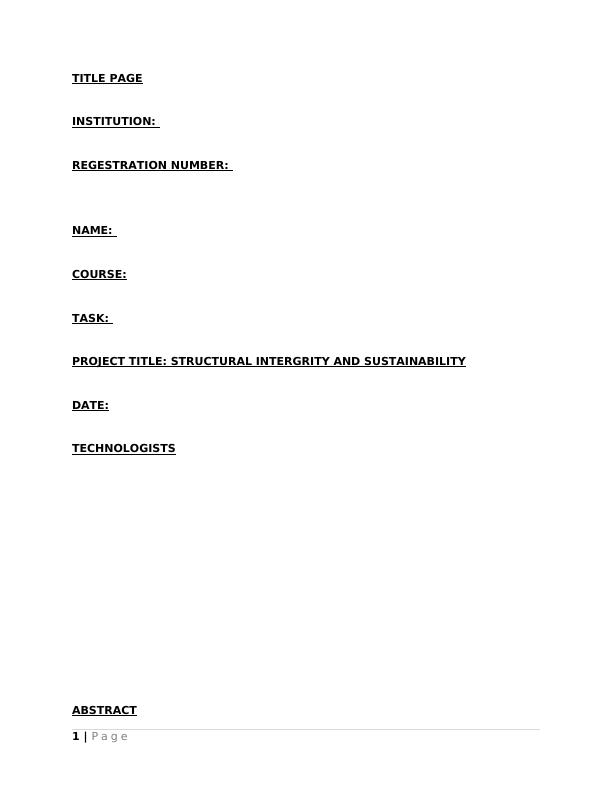
In this project we will conduct an engineering research on creating a material which
is environment friendly that can be used widely in construction activities. This
material should be organic and it will replace carbon emitting materials in the near
future. In the recent times much concern has been put in eradicating global
warming and the material under research is the best shot for achieving this
necessity. The material is supposed to be cheap, organic and to have good physical
properties such as high strength and should be resistant to extreme weather
conditions. Bamboo, has been suggested as a relevant material (Rowosky 1999),
and therefore we will embark on the methods of how to strengthen the material so
that it can be effective in engineering industries. Market research will be conducted
on the product, this will investigate the product availability and how to minimize the
cost. In the market research will formulate a hypothesis of how bamboo and other
organic materials will compete with the existing materials such as steel, aluminum
and other alloys.
INTRODUCTION:
Since time immemorial metals have been an important material in construction. The
development of many nations have been attributed to the presence of this
important material. Millions of tons of the material have been mined all over the
globe leaving exposed quarries and causing all manner of environmental pollution.
This pollution has led to spreading of diseases and even extinction of some plant
and animal species. But in the recent past engineers have been trying to solve the
problem caused by carbon emitting substance. There has been various solution
devised but one of the best is the use of organic reinforced fibers to replace metal
and hydrocarbons. These materials cause a lot of carbon emission into the
atmosphere. But as for now various materials have been suggested, they include
bamboo, hardwood and various kinds of softwood e.g. eucalyptus. In this paper we
will focus on bamboo and how it is the most suitable material in construction.
Bamboo belong to the same classification of gigantic grasses. It grows in areas
having suitable rainfall of over 1200mm, most bamboo forest can be found between
altitude of 20 -3000 meters. This means that bamboo is a common tree since it can
grow in almost all of the countries in the world.
The availability of bamboo makes it both cheap and economical in construction.
Although bamboo has been used in centuries in traditional construction of houses
and other household facilities, it can further be put into good use when it is
reinforced with concrete to make massive buildings.
According to the research conducted by various universities and research
institutions it has been shown that bamboo has good mechanical properties. These
properties include its resistance to creep and fatigue, its strength and also it has
minimal weight which makes it easier to transport. This is unlike steel which has the
same properties but its production and transportation are difficult.
2 | P a g e
is environment friendly that can be used widely in construction activities. This
material should be organic and it will replace carbon emitting materials in the near
future. In the recent times much concern has been put in eradicating global
warming and the material under research is the best shot for achieving this
necessity. The material is supposed to be cheap, organic and to have good physical
properties such as high strength and should be resistant to extreme weather
conditions. Bamboo, has been suggested as a relevant material (Rowosky 1999),
and therefore we will embark on the methods of how to strengthen the material so
that it can be effective in engineering industries. Market research will be conducted
on the product, this will investigate the product availability and how to minimize the
cost. In the market research will formulate a hypothesis of how bamboo and other
organic materials will compete with the existing materials such as steel, aluminum
and other alloys.
INTRODUCTION:
Since time immemorial metals have been an important material in construction. The
development of many nations have been attributed to the presence of this
important material. Millions of tons of the material have been mined all over the
globe leaving exposed quarries and causing all manner of environmental pollution.
This pollution has led to spreading of diseases and even extinction of some plant
and animal species. But in the recent past engineers have been trying to solve the
problem caused by carbon emitting substance. There has been various solution
devised but one of the best is the use of organic reinforced fibers to replace metal
and hydrocarbons. These materials cause a lot of carbon emission into the
atmosphere. But as for now various materials have been suggested, they include
bamboo, hardwood and various kinds of softwood e.g. eucalyptus. In this paper we
will focus on bamboo and how it is the most suitable material in construction.
Bamboo belong to the same classification of gigantic grasses. It grows in areas
having suitable rainfall of over 1200mm, most bamboo forest can be found between
altitude of 20 -3000 meters. This means that bamboo is a common tree since it can
grow in almost all of the countries in the world.
The availability of bamboo makes it both cheap and economical in construction.
Although bamboo has been used in centuries in traditional construction of houses
and other household facilities, it can further be put into good use when it is
reinforced with concrete to make massive buildings.
According to the research conducted by various universities and research
institutions it has been shown that bamboo has good mechanical properties. These
properties include its resistance to creep and fatigue, its strength and also it has
minimal weight which makes it easier to transport. This is unlike steel which has the
same properties but its production and transportation are difficult.
2 | P a g e

TABLE OF CONTENTS
TITLE
PAGE.....................................................................................................................
...........................................1
ABSTRACT
..............................................................................................................................
..................................2
INTRODUCTION......................................................................................................
.................................................2
BACKGROUND
INFORMATION........................................................................................................
......................4
METHODOLOGY......................................................................................................
...............................................4
DATA
ANALYSIS...............................................................................................................
.......................................6
DISCUSSION............................................................................................................
.................................................8
LITRATURE REVIEW
.......................................................................................................................
.....................11
CONCLUSION.........................................................................................................
................................................19
3 | P a g e
TITLE
PAGE.....................................................................................................................
...........................................1
ABSTRACT
..............................................................................................................................
..................................2
INTRODUCTION......................................................................................................
.................................................2
BACKGROUND
INFORMATION........................................................................................................
......................4
METHODOLOGY......................................................................................................
...............................................4
DATA
ANALYSIS...............................................................................................................
.......................................6
DISCUSSION............................................................................................................
.................................................8
LITRATURE REVIEW
.......................................................................................................................
.....................11
CONCLUSION.........................................................................................................
................................................19
3 | P a g e
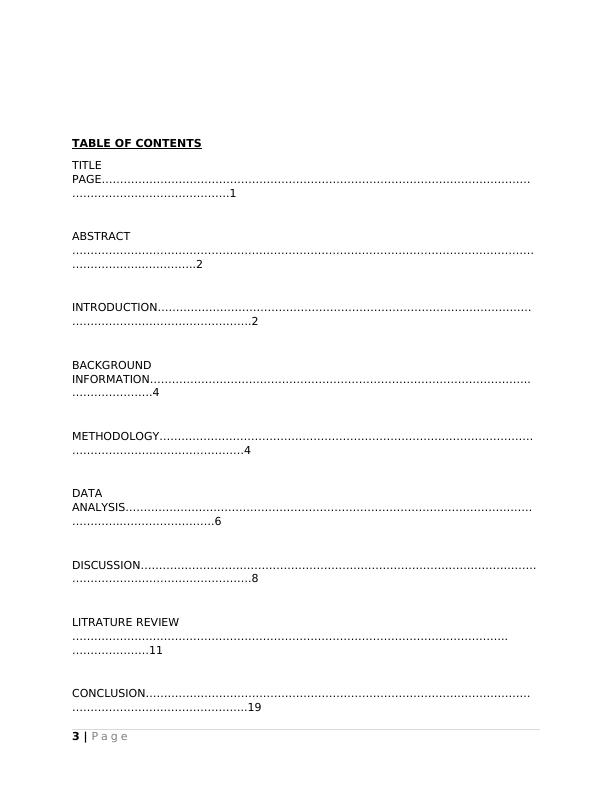
RECOMMENDATION................................................................................................
............................................19
REFRENCES............................................................................................................
...............................................20
BACKGROUND INFORMATION
This project is in accordance to the Paris act of 22nd October 2018 which its main
aims is to lower the amount of carbon emissions and also to lower the cost of
materials used in construction. The major goals of the project were listed as follows;
(i) To generate jobs by creating cheap and high quality products.
(ii) To eliminate the issues of global warming caused by other carbon emitting
products
(iii) To redesign a classical supportive reinforced re-bar concrete beam structure by
finding and coupling an organic material, composite material that could replace an
ever-growing in price steel. (ASTM 1994)
METHODOLOGY
(i)There would be creation of a user profile and a product life cycle map of a typical
reinforced beam. This will include an innovation matrix which will give a better
understanding of the design process and relationships between material, people,
context vs material things, service, system.
4 | P a g e
............................................19
REFRENCES............................................................................................................
...............................................20
BACKGROUND INFORMATION
This project is in accordance to the Paris act of 22nd October 2018 which its main
aims is to lower the amount of carbon emissions and also to lower the cost of
materials used in construction. The major goals of the project were listed as follows;
(i) To generate jobs by creating cheap and high quality products.
(ii) To eliminate the issues of global warming caused by other carbon emitting
products
(iii) To redesign a classical supportive reinforced re-bar concrete beam structure by
finding and coupling an organic material, composite material that could replace an
ever-growing in price steel. (ASTM 1994)
METHODOLOGY
(i)There would be creation of a user profile and a product life cycle map of a typical
reinforced beam. This will include an innovation matrix which will give a better
understanding of the design process and relationships between material, people,
context vs material things, service, system.
4 | P a g e
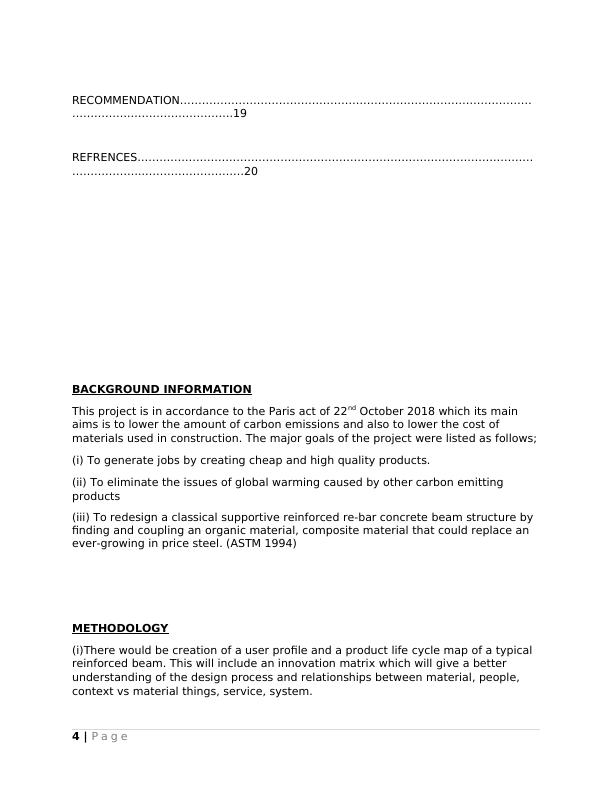
(ii)Analysis of properties of materials under investigation will be conducted by the use of young
modulus table, calculation will be done to obtain the optimum values for the amount of stress
and strain needed.
(iii) The next process will be Investigation engineering properties like thermal
contraction and expansion, corrosiveness, bonding properties, the carbon footprint
for its extraction, growth, transformation. Engineering: mechanics, materials,
design.
(iv) Development of an ethics/sustainability matrix, combined with engineering data
collected from the previous exercise to give a clearer insight of the selected few
products/composites that fall within the scope of my intended goal.
(v) Assignment of points for best performance of material, the choice will be
justified by allocating score to each material, the higher the score, the more chance
to be selected.
(vi)There will be creation of the first storyboard of design intention. This will include
Innovation, designing for change and all design essentials.
(vi) Geometrical model of a typical rectangular shaped beam will be generated with
its reinforcement as well as it’s free body diagram, the loading configuration,
bending moment diagram and deflected form of the beam diagram which indicate
the support reactions and if they are, hence, to calculate which forces, and
reactions are going to act on the beam.
(vii) Calculate the second moment of area, which provides a measure of
effectiveness a particular and area to resist bending deformation upon the
established load criteria: The larger the second of area is, the better the resistance
to bending will be Structural integrity
(viii)Designing against failure I will have to find and balance the optimum second
moment of area for both materials a concrete and organic/composite reinforcement
to find the equilibrium conditions for my design.
(ix) Identification of a potential place for stress intensity factor, a crack, possibly
close to the bonding edge of the two materials. The toughness of the material
should be conducted with alignment with BS EN ISO standard 12737 using KIC
calculator
(x)After accomplishing calculations, there will be generation of rough sketches of
different design, this will be accomplished by using idea generators such as
associative thinking for incorporations of the system level innovation. This means
that the single beam could be a part of the components system platform (LEGO
blocks concept) product, system and service level of innovation.
(xi)Perform a morphological analysis, and checklist which will help me to choose the
right three selections of the design proposals after which I will validate the
engineering performance by making sure it is within my set engineering/design
criteria.
5 | P a g e
modulus table, calculation will be done to obtain the optimum values for the amount of stress
and strain needed.
(iii) The next process will be Investigation engineering properties like thermal
contraction and expansion, corrosiveness, bonding properties, the carbon footprint
for its extraction, growth, transformation. Engineering: mechanics, materials,
design.
(iv) Development of an ethics/sustainability matrix, combined with engineering data
collected from the previous exercise to give a clearer insight of the selected few
products/composites that fall within the scope of my intended goal.
(v) Assignment of points for best performance of material, the choice will be
justified by allocating score to each material, the higher the score, the more chance
to be selected.
(vi)There will be creation of the first storyboard of design intention. This will include
Innovation, designing for change and all design essentials.
(vi) Geometrical model of a typical rectangular shaped beam will be generated with
its reinforcement as well as it’s free body diagram, the loading configuration,
bending moment diagram and deflected form of the beam diagram which indicate
the support reactions and if they are, hence, to calculate which forces, and
reactions are going to act on the beam.
(vii) Calculate the second moment of area, which provides a measure of
effectiveness a particular and area to resist bending deformation upon the
established load criteria: The larger the second of area is, the better the resistance
to bending will be Structural integrity
(viii)Designing against failure I will have to find and balance the optimum second
moment of area for both materials a concrete and organic/composite reinforcement
to find the equilibrium conditions for my design.
(ix) Identification of a potential place for stress intensity factor, a crack, possibly
close to the bonding edge of the two materials. The toughness of the material
should be conducted with alignment with BS EN ISO standard 12737 using KIC
calculator
(x)After accomplishing calculations, there will be generation of rough sketches of
different design, this will be accomplished by using idea generators such as
associative thinking for incorporations of the system level innovation. This means
that the single beam could be a part of the components system platform (LEGO
blocks concept) product, system and service level of innovation.
(xi)Perform a morphological analysis, and checklist which will help me to choose the
right three selections of the design proposals after which I will validate the
engineering performance by making sure it is within my set engineering/design
criteria.
5 | P a g e
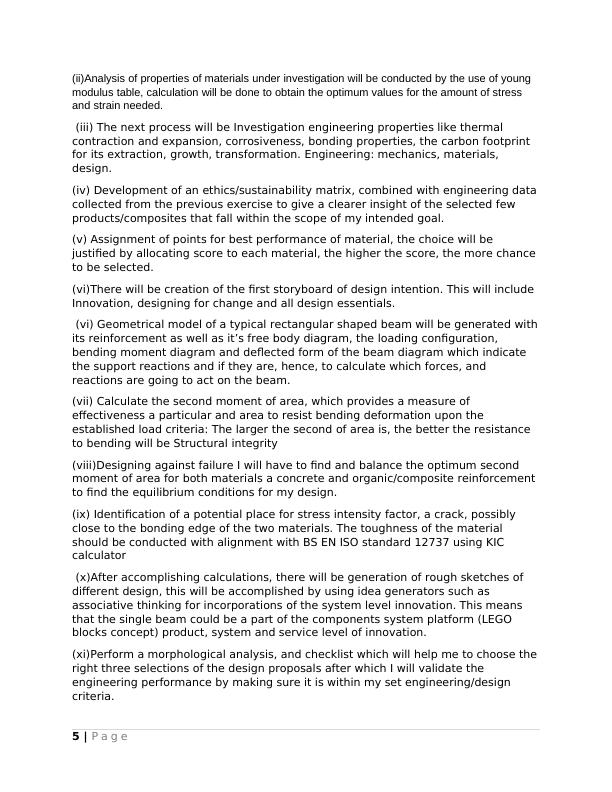
(xii)Create parametric drawings plan views, front views, back views, exploded views
and orthographic sketches of the beam design and will consider some variations as
well as incorporation of the system idea solution, this means that the single beam
could be a part of the components system platform (LEGO blocks concept) product,
system and service level of innovation.
(xiii)Designing the production process should be a straight forward. I would stick to
design production process by the use of old molding method used for concreting
reinforced beams;
(xiv)Designing of reinforced concrete beam will be molded by software such as in
Autodesk software and Revit. Also mapping tool will be used to record process and
outcome of the innovation.
(xv) Create final poster to elaborate the final design.
OBJECTIVES
This workflow, is pursued to achieve a product, material, service innovation. Where
a product is “The Green Beam” that is lowering the price, reducing carbon footprint,
generates jobs in farming industry as well as building trust of the architects and
engineers by the combination of above measures. (Hua 1991)
DATA ANALYSIS
Steel tensile strength properties
High yield
steel bar
25 mm 20 mm 16 mm 12 mm 10mm
Maximum
tensile
force(Kn)
390 225 140 80 36
Yield
stress(N/mm3
)
680 615 495 551 380
Tensile 790 713 711 690 460
6 | P a g e
and orthographic sketches of the beam design and will consider some variations as
well as incorporation of the system idea solution, this means that the single beam
could be a part of the components system platform (LEGO blocks concept) product,
system and service level of innovation.
(xiii)Designing the production process should be a straight forward. I would stick to
design production process by the use of old molding method used for concreting
reinforced beams;
(xiv)Designing of reinforced concrete beam will be molded by software such as in
Autodesk software and Revit. Also mapping tool will be used to record process and
outcome of the innovation.
(xv) Create final poster to elaborate the final design.
OBJECTIVES
This workflow, is pursued to achieve a product, material, service innovation. Where
a product is “The Green Beam” that is lowering the price, reducing carbon footprint,
generates jobs in farming industry as well as building trust of the architects and
engineers by the combination of above measures. (Hua 1991)
DATA ANALYSIS
Steel tensile strength properties
High yield
steel bar
25 mm 20 mm 16 mm 12 mm 10mm
Maximum
tensile
force(Kn)
390 225 140 80 36
Yield
stress(N/mm3
)
680 615 495 551 380
Tensile 790 713 711 690 460
6 | P a g e
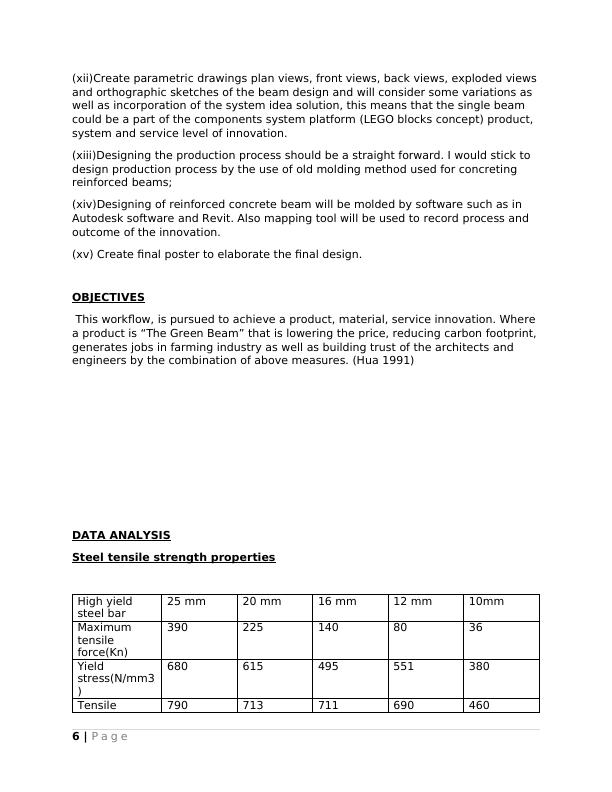
End of preview
Want to access all the pages? Upload your documents or become a member.
Related Documents
Application of Composite Reinforcement Bamboo for Lentil Beam Redesignlg...
|39
|7521
|6
Can Bamboo Replace Steel and Timber in the Construction Industry?lg...
|4
|626
|364
A research in different types and applications of the composite materials in engineering Report 2022lg...
|19
|3835
|16
Environmental Sustainability in Construction: Selection of Low Carbon Construction Materialslg...
|11
|2264
|281
Design and Analysis of Composite Leaf Spring: A Reviewlg...
|6
|6259
|101
Low Velocity Impact on Compressed Gas Storage Tanklg...
|44
|10450
|2
